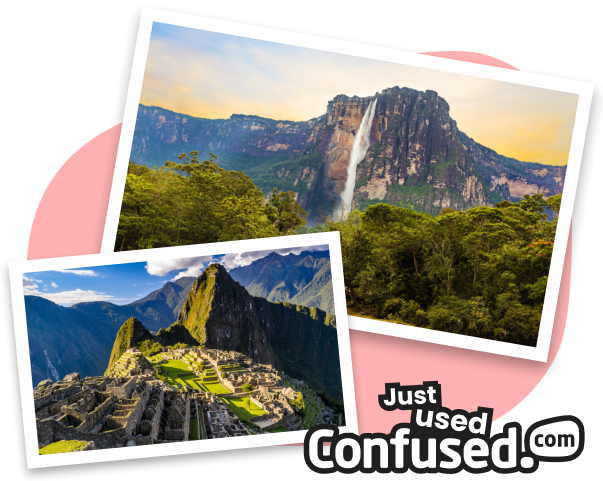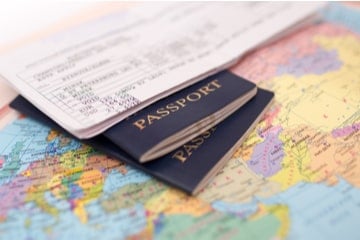-
Emergency medical expenses, if you need to receive emergency medical treatment.
-
Repatriation, if you need to be returned home to the UK to receive medical treatment.
-
Cancellation or curtailment, if you need to cancel your trip or come home early for an unexpected reason.
-
Travel disruption, if you experience travel delays because of things like strikes or mechanical issues.
-
Baggage cover, if your personal possessions are damaged, stolen or accidentally lost.
How do I compare South America travel insurance quotes?
You can compare travel insurance for South America in 3 simple steps:
Tell us about your trip
Tell us a bit about you
Compare quotes
1Correct as of October 2025
Choosing the right travel insurance for your trip to South America
You can choose between the following policy types depending on your needs:
Top tip: Getting multi-trip travel insurance? You can choose between worldwide travel insurance that either includes or excludes the USA, Mexico, Canada and the Caribbean. It depends where you'll be going.
For the majority of countries in South America, you'll likely need worldwide travel insurance that excludes the USA, Mexico, Canada and the Caribbean. This is usually slightly cheaper than policies that cover these countries. But, it's best to check before buying your travel insurance to make sure you're getting the right cover.
Travel insurance for popular activities in South America
There are some activities that aren't usually covered by standard travel insurance. So, it's worth thinking about what you'll be getting up to in South America.
If your policy doesn't provide the level of cover you need for the things you plan to do, you might need a policy add-on. Just like the name suggests, you can add them to your policy for enhanced cover. But, keep in mind you'll need to pay an extra cost.
Let's take a look at them:
-
Cruise insurance. If you'll be stopping at certain parts of South America as part of a cruise, you'll need cruise travel insurance. It can cover you for the unique things that can go wrong while at sea, like missed ports.
-
Scuba diving insurance. Malpelo Island in Colombia is considered one of the best diving sites in the world, and is popular with people who want to swim with sharks! This add-on can offer enhanced cover for scuba diving, including diving to depths past 18 metres.
-
Skiing or snowboarding. When you think of South America, skiing might not be the first thing that comes to mind. But, San Carlos de Bariloche in Argentina is popular with skiers all year round. If you're planning to go there, you'll need a winter sports insurance add-on.
-
Trekking and hiking insurance. Are you planning on trekking Torres del Paine National Park in Chile? Or, maybe you have plans to hike Tayrona National Park in Colombia? If you are, hiking and trekking won't be covered by your standard insurance. So, you'll need this add-on.
What does South America travel insurance cover?
Coverage can vary from insurer to insurer. But, to give you an idea of what to expect, here's what's usually offered by standard travel insurance:
What our travel insurance expert says
What countries are in South America?
South America is a big continent! It's made up of 12 sovereign states, 3 non-sovereign dependent territories and an internal territory.
Sovereign states
-
Bolivia
-
Chile
-
Colombia
-
Ecuador
-
Guyana
-
Paraguay
-
Peru
-
Suriname
-
Uruguay
-
Venezuela
Dependent territories
- The Falkland Islands
- South Georgia
- The South Sandwich Islands
Internal territory
-
French Guiana
The following might also be considered parts of South America to some insurers:
-
Kingdom of the Netherlands
-
British Overseas Territory of Ascension
-
Saint Helena
-
Tristan da Cunha
-
Bouvet
-
Panama
-
The Island Republic of Trinidad and Tobago
South America travel tips
Whether you'll be hiking Machu Picchu or exploring the many tropical coastlines, follow these tips for a memorable experience:
-
Safety
Crime rates can be high in South America. Kidnappings, robbery and pickpocketing can be common. GOV.UK has specific guidance on how to stay safe, depending on which South American country you're visiting.
-
Laws and customs
In some South American countries, you'll need to make sure you're carrying photo ID and your passport with an entry stamp at all times.
Top tip: Visiting a South American country that doesn't require this? Consider keeping your passport in a safe, secure place and carrying a copy of it instead.
-
Volunteering
If you're planning to volunteer during your time in South America, make sure that you're using a reputable, licenced tour operator. You should also make sure there's a local agent to assist if you have an emergency or need help. It's also worth considering volunteer travel insurance.
-
Altitude sickness
Are you planning to go on a hike or a trek? If you are, you'll need to think about altitude sickness. It's a condition that can happen when your body struggles to adjust to lower oxygen levels at a higher elevation.
The best way to prevent it is to stay hydrated, take your time, and stick to designated routes with your tour guide. Keep in mind, phone service can be limited in more rural areas. So, make sure someone knows where you're going and when you should be back.
-
Road travel
Many travellers opt to explore various South American countries by car. But, roads in South America can be in poor condition and careless driving can be common.
If you'll be exploring South America by road, make sure you're wearing your seatbelt and be wary of carjacking. For added safety, you could consider going with an official tour company.
Planning to use a taxi to get around? If you are, book through your hotel to make sure you're using a legitimate taxi company. There's safety in numbers, too. So, if you can, always travel in a group.
Travel guides to help with your South America trip
Our service is free and compares a wide range of trusted household names. Confused.com is an intermediary and receives commission from theidol.com if you decide to buy through our website which is based on a percentage of the total annual premium. We pride ourselves on impartiality and independence – therefore we don't promote any one insurance provider over another.









